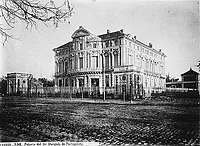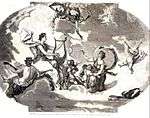Palacio del Marqués de Portugalete
The Palacio del Marqués de Portugalete was a grand ornate palace built in the 1860s, located at number 56 of the Calle de Alcalá, on the corner of Calle Alfonso XI, in Madrid. Also known as the Palace of Bailén, it belonged to the family of Francisco Javier Castaños y Aragorri (a descendant of General Castaños, the victor of the battle of Bailén). It was built by the architect Adolfo Ombretch, who also built the nearby palace of Linares. For many years it was a venue for the wealthy elite to meet and discuss national politics. It was demolished after the Spanish Civil War, and in 1946, in its place, was constructed the building of the National Institute of Forecast, now occupied by the National Institute of Health. [1]



History
The palace was built during the reign of Isabel II. Its owner was the Marquis of Portugalete and the Duke of Bailén, originally called the "Duchy of Bailén Castaños", a title created in 1833 by King Ferdinand VII in favor of General Francisco Javier Castaños y Aragorri Urioste y Olavide. It was later transformed into perpetual and hereditary in 1847 by Queen Isabel II. As the General Castaños died childless, the property passed into the peerages of Luis Ángel de Carondelet y Castaños, his sister's son, and her husband the Baron of Carondelet, the 2nd Marquisate of Portugalete.
The plans and the direction of the construction of the building were executed by the French architect Adolfo Ombrecht. Its interior had a ballroom decorated with flowers, a chapel for religious events, a billiard room, a hall of portraits, bathrooms decorated in Pompeian style by the painter Oreste Mancini, a gallery museum, a music hall and a large number of dependencies. Carrara marble is heavily used, and there are tapestries and paintings by Francisco Goya, Vicente López, Palmaroli, Eduardo Rosales, Murillo, Pradilla, Madrazo, Gisbert, Casado del Alisal, etc., sculptors being the most renowned Benlliure, ebony and ivory furnitures, colorful chandeliers and windows.[2]
The palace was built in the center of the plot, having an inner courtyard with garden, the outside was enclosed by a fence.
For the construction was used the stone and the brick alternately, stone for the main part as corners, gables, cornices, doorways and windows. To highlight the design of the central body of the facade of the calle de Alcalá forming a curved space.
At the death without descendants of the 3rd Duke of Bailén, Eduardo de Carondelete y Donado in 1882 the titles passed to his carnal niece, Encarnación Fernández de Córdoba, but the palace and its contents were inherited by his widow, María Dolores del Collado y Echagüe, the latter, was the one who really gave luster and fame to that palace. And she did especially through her celebrated parties and meetings.
For many years the palace was a meeting place for the wealthy and political classes of the time as Cánovas del Castillo. In its halls national politics was so commonplace that once, leaving Cánovas this palace with a large representation of the Government, a reporter asked: "Mr. President, have been Council?"
It was demolished after the Spanish Civil War to make way for new forms of urbanism and in 1946, the building of the National Insurance Institute, later called the National Institute of Health was built in its place. At present, the current building is owned by the Ministry of Health, Social Services and Equality of the Government of Spain.
Gallery
 Roof of a room of the Palacio del Marqués de Portugalete. Painted by Eduardo Rosales. Photo of 1871.
Roof of a room of the Palacio del Marqués de Portugalete. Painted by Eduardo Rosales. Photo of 1871. Aerial view of the Plaza de la Independencia and the Puerta de Alcalá, with the Palacio del Marqués de Portugalete bottom right. Photo: Juanjo for Urbanity (late-19th c.).
Aerial view of the Plaza de la Independencia and the Puerta de Alcalá, with the Palacio del Marqués de Portugalete bottom right. Photo: Juanjo for Urbanity (late-19th c.). Palacio del Marqués de Portugalete, engraving from photograph of Jean Laurent, according to the index of the first page of the magazine La Ilustración de Madrid.
Palacio del Marqués de Portugalete, engraving from photograph of Jean Laurent, according to the index of the first page of the magazine La Ilustración de Madrid. Palacio del Marqués de Portugalete. Drawing of 1870.
Palacio del Marqués de Portugalete. Drawing of 1870.